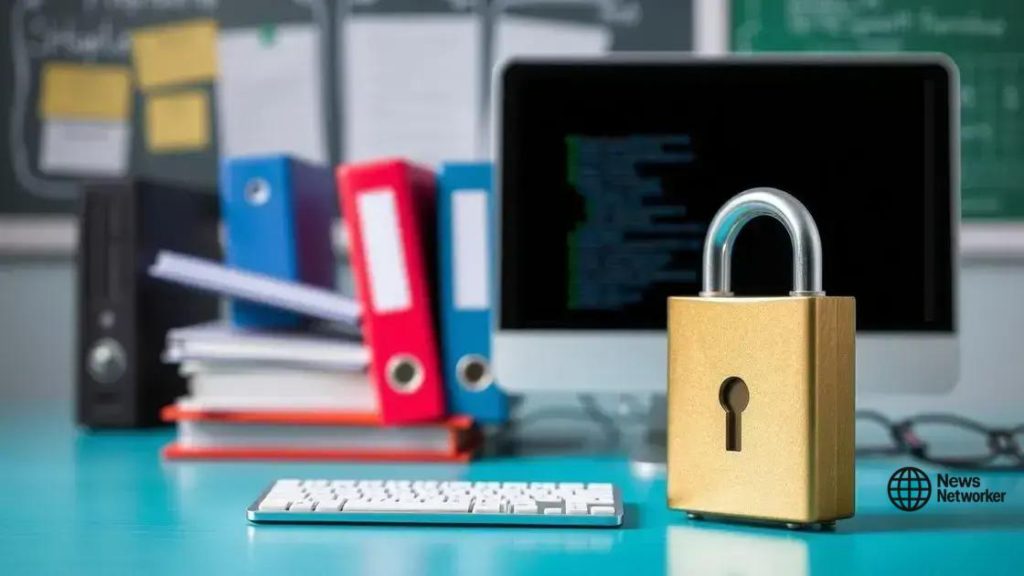Data privacy for student academic records is essential

Data privacy for student academic records involves protecting sensitive information through legal frameworks, best practices, and advanced security technologies to prevent unauthorized access and data breaches.
Data privacy for student academic records has become a pressing concern in education today. With increasing digitalization, protecting sensitive student information is crucial. Are schools doing enough to keep this data secure? Let’s delve into the key aspects of data privacy and its significance for students.
Understanding data privacy in education
Understanding data privacy in education is crucial for ensuring that students’ sensitive information is protected. With the rise of technology in classrooms, schools must prioritize safeguarding this data. In this section, we will explore the importance of data privacy and how it can be maintained effectively.
Why Data Privacy Matters
Data privacy is essential because it builds trust between students and educational institutions. When students know their information is safe, they are more likely to engage and participate in learning. Additionally, breaches can lead to severe consequences, including identity theft and misuse of personal information.
Key Principles of Data Privacy
- Consent: Students should be informed about how their data will be used and must provide consent for its use.
- Limitation: Schools should collect only the data necessary for educational purposes.
- Security: Measures need to be implemented to protect data from unauthorized access.
Another important aspect of data privacy is understanding legal obligations. Various laws, such as FERPA (Family Educational Rights and Privacy Act), dictate how schools must handle student records. Adhering to these regulations is crucial for educational institutions to avoid penalties and ensure compliance.
Furthermore, technology plays a vital role in data privacy. Schools are increasingly relying on digital platforms to manage records. It’s essential to choose software solutions that prioritize data security and have measures in place to protect sensitive information. This includes encryption, regular updates, and secure access protocols.
To enhance data privacy in education, schools can also conduct training for staff on best practices. Educators should be aware of the significance of protecting student information and the potential risks involved. This collective responsibility helps foster a safer educational environment.
The impact of data breaches on student records
The impact of data breaches on student records can be severe and far-reaching. When educational institutions fail to protect sensitive information, the consequences can affect students, families, and the schools themselves. Understanding these impacts is vital for improving data security practices.
Consequences for Students
Students may face identity theft and fraud if their personal data is compromised. This risk can lead to significant emotional distress, as students worry about the misuse of their information. Moreover, severe breaches can hinder students’ futures, affecting their ability to secure scholarships, internships, or even job opportunities.
Effects on Schools
For educational institutions, a data breach can result in hefty fines and legal liabilities. Schools may find themselves spending significant resources on remediation and compensation for affected individuals. This financial strain can divert funds from educational programs, negatively impacting the learning environment.
- Reputation Damage: Schools can lose trust from parents and students, which may lead to declining enrollments.
- Compliance Issues: Failing to meet legal data security standards can result in audits and penalties.
- Operational Disruption: Recovery efforts post-breach can disrupt daily operations and educational services.
Additionally, data breaches can lead to increased scrutiny from regulatory bodies. Schools must demonstrate their commitment to safeguarding student data by investing in better security measures and policies. This includes regularly training staff on data protection practices and implementing technology solutions that enhance security.
It’s essential to foster a culture of data privacy in educational settings. Schools can stress the importance of confidentiality by educating students and staff about best practices for data handling. Encouraging a proactive approach can significantly reduce the risk of breaches.
Legal frameworks protecting student data

Legal frameworks protecting student data are crucial for establishing guidelines that schools must follow. Understanding these laws helps ensure that students’ personal information is kept secure and private. In the educational landscape, several important regulations play a significant role in safeguarding student data.
Key Regulations
Two central regulations in the United States are the Family Educational Rights and Privacy Act (FERPA) and the Children’s Online Privacy Protection Act (COPPA). FERPA grants parents and eligible students rights regarding their educational records, while COPPA imposes requirements on websites and online services to protect the privacy of children under 13.
- FERPA: It ensures that schools cannot disclose personally identifiable information without consent.
- COPPA: It regulates the collection of information from children under 13 years by online services.
- Gramm-Leach-Bliley Act: This act includes protections for personal financial information related to students.
Moreover, some states have established their own laws enhancing student data protection. These state laws often require schools to implement additional measures for data security. Such measures can include encryption, access controls, and incident response plans.
Maintaining compliance with these laws is essential for schools not just to avoid legal issues but also to build trust within the community. Schools must regularly train staff on legal requirements and best practices to ensure everyone’s familiar with the procedures protecting student data.
The ongoing evolution of technology means that laws must adapt to new challenges. As schools continue to incorporate digital tools into their educational processes, staying informed on legal frameworks is more important than ever. Schools should periodically review their policies and practices to align with changing regulations.
Best practices for maintaining data privacy
Maintaining data privacy in educational settings is essential to protect sensitive information about students. By following best practices, schools can significantly reduce the risk of data breaches and foster a safe environment for learning.
Establish Clear Data Policies
Creating clear policies regarding data privacy is crucial for all educational institutions. These policies should outline how data is collected, stored, and shared, ensuring that everyone is aware of their responsibilities. Regularly updating these policies keeps them relevant as technology and laws evolve.
- Data Minimization: Only collect data that is necessary for educational purposes.
- Access Controls: Limit who can access sensitive information based on their roles.
- Encryption: Use encryption methods to protect data both in transit and at rest.
Training staff on the importance of data privacy is another key practice. Educational professionals must understand the implications of mishandling data. Regular training sessions help reinforce the importance of safeguarding student information.
Implement Strong Security Measures
Utilizing technology effectively is vital for data protection. Schools should adopt robust security measures such as firewalls, antivirus software, and secure passwords. Having a dedicated IT team ensures that systems are properly maintained and up-to-date.
Monitoring and auditing data access regularly can help identify potential weaknesses and areas needing improvement. By conducting routine checks, schools can stay ahead of possible threats and ensure compliance with regulations.
Engaging with parents and students about data privacy is also beneficial. Open communication helps build trust, as families feel informed and empowered regarding the handling of their personal information. Schools can send out newsletters or hold workshops to educate families about their data privacy rights and how schools protect that data.
Tools and technologies for enhancing data security
Tools and technologies for enhancing data security are essential for protecting student information in educational settings. With technology constantly evolving, schools must stay up-to-date with the latest solutions to safeguard sensitive data.
Encryption Software
One of the most effective tools is encryption software. This software transforms data into a secure format that unauthorized users cannot read. Schools can use encryption for emails, files, and databases containing personal information of students.
- End-to-End Encryption: This ensures that data is encrypted from the sender to the receiver, providing maximum protection.
- File Encryption: Encrypting individual files adds an extra layer of security.
Access Control Solutions
Implementing strong access control solutions helps limit who can view or edit sensitive information. Schools should create a hierarchy of access based on roles, ensuring that only authorized personnel can access specific data. Additionally, utilizing multi-factor authentication (MFA) adds an additional layer of security by requiring more than just a password to access sensitive systems.
Regular backups are also crucial for data security. Using cloud storage solutions enables schools to keep data safe while providing easy access for authorized users. In the event of a data loss, schools can quickly restore their information without significant disruption.
Cybersecurity awareness training for staff is another vital component of enhancing data security. Regular training helps employees recognize potential threats such as phishing attacks or malware. Awareness can greatly reduce the chances of a data breach caused by human error.
Finally, using security monitoring tools can help detect and respond to threats in real-time. These tools can alert school administrators to unusual activities, allowing them to act quickly to mitigate risks. By leveraging these technologies, schools can create a more secure environment for student data.
In today’s digital age, protecting student data is more important than ever. By understanding the legal frameworks, implementing best practices, and utilizing effective tools and technologies, schools can create a safer environment for students. Awareness and training programs can prepare staff and students to recognize and respond to potential threats, contributing to a culture of data privacy. Ultimately, by prioritizing data security, educational institutions can build trust with families and ensure that student information remains confidential and protected.
FAQ – Frequently Asked Questions about Data Privacy for Student Academic Records
What is data privacy?
Data privacy refers to the protection of personal information shared by individuals, ensuring it is used appropriately and safeguarded from unauthorized access.
Why is data privacy important in education?
Data privacy is important in education to protect students’ sensitive information from breaches, which can lead to identity theft and other risks.
What are some best practices for ensuring data privacy?
Best practices include implementing clear policies, training staff, using encryption, and limiting access to sensitive information.
How can technology help in maintaining data privacy?
Technology can enhance data privacy by providing encryption tools, access control systems, and monitoring software to detect and respond to security threats.





